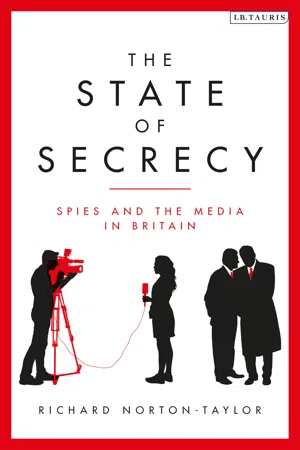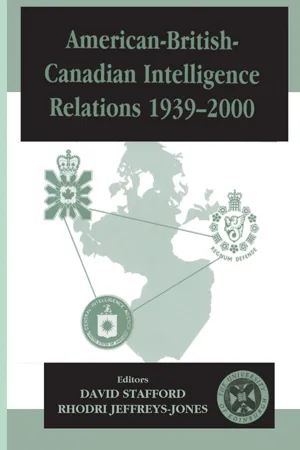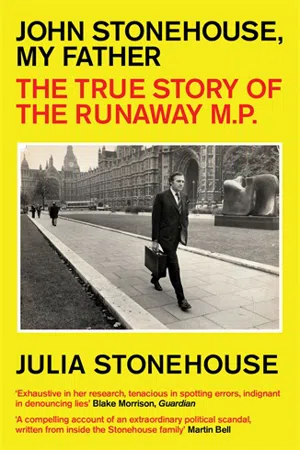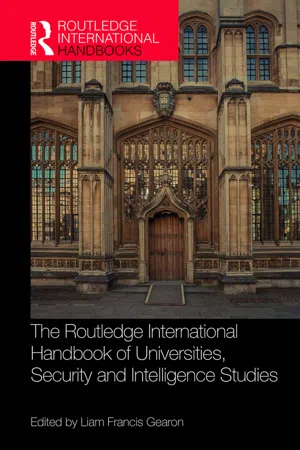Cambridge Five
The Cambridge Five refers to a group of British spies who passed information to the Soviet Union during the Cold War. The members included Kim Philby, Donald Maclean, Guy Burgess, Anthony Blunt, and John Cairncross. They infiltrated various government institutions and provided classified information to the Soviets, causing significant damage to Western intelligence efforts.
5 Key excerpts on "Cambridge Five"
- eBook - ePub
The State of Secrecy
Spies and the Media in Britain
- Richard Norton-Taylor(Author)
- 2020(Publication Date)
- I.B. Tauris(Publisher)
...8 Spies: More uses and abuses Donald Maclean, perhaps the most productive member of the notorious Cambridge spy ring compared espionage to being a lavatory attendant. ‘It stinks,’ he is reported to have said, ‘but someone has to do it’. 1 The media, MPs and ministers – when it suits them – treat intelligence agencies as very special, almost untouchable, certainly a cut above the rest of government. Spying is dangerous. It can also be a dirty business. The world of spies, spooks, as they are now commonly called, attracts oddballs, adventurers and the vulnerable – as well as committed ideologues. In his foreword to Kim Philby’s autobiography, My Silent War, Graham Greene, a wartime MI6 officer and convert to Catholicism, compared the Cambridge spy to Catholics in Elizabethan England. ‘Like many Catholics who, in the reign of Elizabeth, worked for the victory of Spain’, Greene wrote, ‘Philby has a chilling certainty in the correctness of his judgment, the logical fanaticism of a man who, having once found a faith, is not going to lose it because of the injustices or cruelties inflicted by erring human instruments.’ If not exactly excusing Philby’s betrayal, Greene was trying to explain it. In Philby’s case, as with other members of the Cambridge spy ring, class was the key to how they got it away with it for so long. Once again, Britain’s national security was undermined by an establishment protected by secrecy...
- Richard J. Aldrich, Richard J. Aldrich(Authors)
- 2005(Publication Date)
- Routledge(Publisher)
...5 5 British Cold War defectors: the versatile, durable toys of propagandists Sheila Kerr DOI: 10.4324/9780203991503-5 It is forty years since Guy Burgess and Donald Maclean defected to the Soviet Union in 1951, and over twenty years since Kim Philby and George Blake followed them behind the Iron Curtain in the 1960s. During this time the images of these defectors have been etched on to the British consciousness by the ebb and flow of the Cold War, and particularly by British, American and Soviet Cold War propaganda. The story of the defectors is a human story of men whose private political convictions had profound personal and international repercussions. What questions ought the historian to ask about the role they played in the post-war period? Within the literature about the Cambridge spies two interrelated themes are apparent; the effect of the defection upon the balance of power between East and West during the Cold War, and the moral and political questions concerning the defectors' decisions to put their ideological convictions before their loyalty to their country. 1 Because the defectors became the toys of Cold War propagandists, perhaps the first impulse of the historian is to disentangle the facts from the fiction about the defectors. This process was begun by British journalists who fought against official censorship and challenged government statements about Maclean, Burgess and Philby. When the Soviets began to use these men as channels for their propaganda Western officials, academics and journalists retaliated by exposing and challenging Soviet propaganda. British and American writers have created additional myths by sensationalizing the exploits of these men...
- Rhodri Jeffreys-Jones, David Stafford, Rhodri Jeffreys-Jones, David Stafford(Authors)
- 2014(Publication Date)
- Routledge(Publisher)
...9 Cold War Alchemy: How America, Britain and Canada Transformed Espionage into Subversion REG WHITAKER At the onset of the Cold War in the late 1940s and early 1950s, a series of high profile Soviet ‘moles’ were uncovered operating at senior and influential levels in the American and British governments. In the United States, sensational testimony before the House Committee on Un-American Activities by ex-Communist and former espionage operative Whittaker Chambers pointed the finger at Alger Hiss, a former senior State Department official, as a long-time agent for Soviet intelligence. Similar public charges were directed at a senior Treasury Department official, Harry Dexter White. Behind these public manifestations, the 1945–46 affair in Ottawa of the defecting GRU cipher clerk, Igor Gouzenko, and the revelations of defecting American Communist agent Elizabeth Bentley, had instigated a widening counter-espionage investigation, later deepened and enriched by the secret Venona Project, which was steadily producing decrypted evidence of Soviet espionage. 1 Then in 1951, the defection of Foreign Office diplomats Guy Burgess and Donald Maclean had a sensational effect, but the long term implications were even more serious. The subsequent uncovering of a wider ‘ring’ including Kim Philby and later Anthony Blunt, had numerous reverberations,, not just upon British security, but on a much wider scale throughout the Western world of counterintelligence. Burgess/Maclean and Hiss/White pointed counter-espionage in certain directions. Coming as they did in the early, formative, period of the Cold War, they served as templates for further action to safeguard security. The British and American cases have some similarities, and thus each powerfully reinforced the lessons drawn from the other. The early Cold War espionage cases on both sides of the Atlantic were all more or less ideologically motivated...
- eBook - ePub
John Stonehouse, My Father
The True Story of the Runaway MP
- Julia Stonehouse(Author)
- 2021(Publication Date)
- Icon Books(Publisher)
...317 20 Secrets and the Security Services: MI5, MI6 and the CIA ‘There is absolutely no doubt at all that a few, a very few, malcontents in MI5, people who shouldn’t have been there in the first place, a lot of them like Peter Wright who were right-wing, malicious, and with serious personal grudges were giving vent to these and spreading damaging malicious stories about some members of that Labour government.’ 1 John Hunt, cabinet secretary, 1973–79 T here was nothing my father could have done to avoid being branded a spy. Although he was completely innocent of the charge, circumstances conspired to allow the miasma of suspicion to fall on him. I don’t entirely blame the press for this, because they were fed the idea by people within the secret services – by which I do not mean the ‘official’ MI5 or MI6, but rather certain rogue elements within those organisations, who were themselves encouraged by the paranoia of the CIA. During the Cold War it was not possible, as a government minister, to avoid having contact with countries behind the so-called Iron Curtain. Political biographies make it clear that politicians of all parties were taking trips to Eastern Europe or Russia, attending receptions and meeting delegations at their embassies, or bumping 318 into personnel from those embassies on the diplomatic circuit. And some of those personnel were spies. They didn’t advertise it, so a politician wouldn’t have known the difference between a regular commercial attaché and a spy who hid behind that official title. If a politician suspected he’d been approached by a spy, it was expected he would report it. When my father was minister of state at the Ministry of Technology, he went to Czechoslovakia to sign a technological agreement and, following an approach, he reported the events to George Wigg, who Harold Wilson had appointed to act as liaison between the Labour government and MI5/MI6...
- Liam Gearon, Liam Francis Gearon(Authors)
- 2019(Publication Date)
- Routledge(Publisher)
...PART III Espionage and the academy Spy stories 13 The Cambridge Spy Ring The mystery of Wilfrid Mann Andrew Lownie Introduction One of the intriguing bit players in the Cambridge Spy Ring is the nuclear physicist Wilfrid Mann, a colleague of Maclean, Burgess and Philby in the Washington Embassy, who was first named as a Soviet agent, along with Anthony Blunt, in Andrew Boyle’s (1979) The Climate of Treason. Opinion still remains divided on whether Mann, codenamed ‘Basil’, was ever a Russian spy with evidence for and against him. This chapter examines some of this evidence. The mystery of Wilfrid Mann Citing confidential information from a CIA source, Boyle claimed that the Israelis ‘passed on to Angleton the name of the British nuclear scientist whom they had unearthed as an important Soviet agent’ just after the Second World War as ‘the price for uninterrupted but informal cooperation with US intelligence’ (Boyle, 1979: 308). Angleton decided to run the operation out of his hip pocket for at least a couple of years. My further understanding is that, besides Angleton and Bedell Smith (who became Director of the CIA in 1950), only Scotty Miler and Jim Rocca were aware of the full game. Whether Hoover himself was fully informed is questionable. What can be said is that the FBI did learn eventually that ‘Basil’ was working under CIA control as a double agent. It is impossible to be more precise than this because no complete chronological record of the operation was kept; next to nothing was committed to paper – or to the supposed hierarchical order of the US Intelligence community. (Boyle, 1979: 308). In the book, Boyle argued that Mann was used to help Maclean interpret for the Soviets information on the latest developments in nuclear physics, which without Basil’s help would have been Greek to Maclean...




